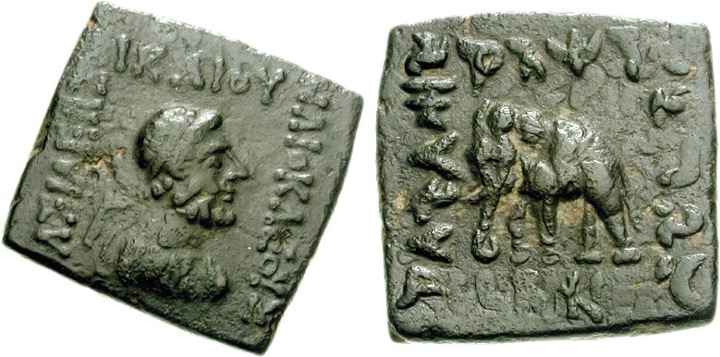91 BCE - 75 BCEΒΑΣΙΛΕΩΣ ΔΙΚΑΙΟΥ ΗΛΙΟΚΛΕΟΥΣ | Maharajasa dhramikasa Heliyakreyasa (of Great king Heliokles the Just)
Overstriking coin
SO_2094_-_Gandhara-Punjab_(uncertain_mint)_(Heliocles_II).jpg
Overstruck variety
Strato_I_Heracles_Nike_2.jpeg
[1]
|
|
Sale(s)Sale(s) ᵖ:
|
Classical Numismatic Group, 72, 14 June 2006, 1046
|
|
|
|
Description
| ObverseInscription or printing placed on the obverse.:
|
ΒΑΣΙΛΕΩΣ ΔΙΚΑΙΟΥ ΗΛΙΟΚΛΕΟΥΣ (Greek) Diademed, draped bust of Zeus right.
|
ReverseInscription or printing placed on the reverse.:
|
Maharajasa dhramikasa Heliyakreyasa (of Great king Heliokles the Just) (Kharoshthi) Elephant walking left. In exergue, monogram.
|
Mint and issuing power
Chronology
| FromIdentifies the initial date in a range assigned in a numismatic context. 91 BCE toIdentifies the final date in a range assigned in a numismatic context.. 75 BCE
|
hellenistic periodTime period of the numismatic object.
|
Physical description
MetalThe physical material (usually metal) from which an object is made.: Bronze 
|
WeightWeight of the numismatic object (in grams). in grams: 9.019.01 g <br />9,010 mg <br />
|
DenominationTerm indicating the value of a numismatic object. Examples: tetradrachm, chalkous, denarius.: denomination B
|
AxisDescribes the directional relationship between the obverse and reverse of a numismatic object.: 1212 mm <br />1.2 cm <br />
|
|
|
StandardStandard.: Indian (Hoover)
|
References
Description
| ObverseInscription or printing placed on the obverse.:
|
ΒΑΣΙΛΕΩΣ ΣΩΤΗΡΟΣ ΔΙΚΑΙΟΥ ΣΤΡΑΤΩΝΟΣ (Greek) Head of bearded Heracles, club over his left shoulder right
|
ReverseInscription or printing placed on the reverse.:
|
Mahārājasa tratarasa dhramikasa Stratasa (of the Great King Strato the Just Savior) (Kharoshthi) Nike standing right, holding wreath in outstretched right arm, palm branch in left
|
Mint and issuing power
Chronology
| FromIdentifies the initial date in a range assigned in a numismatic context. 110 BCE toIdentifies the final date in a range assigned in a numismatic context.. 85 BCE
|
Hellenistic 323-30 BC  periodTime period of the numismatic object. periodTime period of the numismatic object.
|
Physical description
| DenominationTerm indicating the value of a numismatic object. Examples: tetradrachm, chalkous, denarius. ᵖ:
|
denomination B
|
StandardStandard. ᵖ:
|
Indian (Hoover)
|
References
References
- a b Mitchiner, Michael (1975), Indo-Greek and Indo-Scythian coinage, London,
- a b Bopearachchi, Osmund (1991), Monnaies gréco-bactriennes et indo-grecques : catalogue raissoné, Paris, 459 p., 69 pl.
- a b Hoover, Oliver D. (2013), Handbook of coins of Baktria and ancient India : including Sogdiana, Margiana, Areia, and the Indo-Greek, Indo-Skythian, and native Indian states south of the Hindu Kush, fifth century BC to first century, Lancaster-London,


